6.5: Hiroshima and Nagasaki
- Page ID
- 106761
\( \newcommand{\vecs}[1]{\overset { \scriptstyle \rightharpoonup} {\mathbf{#1}} } \)
\( \newcommand{\vecd}[1]{\overset{-\!-\!\rightharpoonup}{\vphantom{a}\smash {#1}}} \)
\( \newcommand{\id}{\mathrm{id}}\) \( \newcommand{\Span}{\mathrm{span}}\)
( \newcommand{\kernel}{\mathrm{null}\,}\) \( \newcommand{\range}{\mathrm{range}\,}\)
\( \newcommand{\RealPart}{\mathrm{Re}}\) \( \newcommand{\ImaginaryPart}{\mathrm{Im}}\)
\( \newcommand{\Argument}{\mathrm{Arg}}\) \( \newcommand{\norm}[1]{\| #1 \|}\)
\( \newcommand{\inner}[2]{\langle #1, #2 \rangle}\)
\( \newcommand{\Span}{\mathrm{span}}\)
\( \newcommand{\id}{\mathrm{id}}\)
\( \newcommand{\Span}{\mathrm{span}}\)
\( \newcommand{\kernel}{\mathrm{null}\,}\)
\( \newcommand{\range}{\mathrm{range}\,}\)
\( \newcommand{\RealPart}{\mathrm{Re}}\)
\( \newcommand{\ImaginaryPart}{\mathrm{Im}}\)
\( \newcommand{\Argument}{\mathrm{Arg}}\)
\( \newcommand{\norm}[1]{\| #1 \|}\)
\( \newcommand{\inner}[2]{\langle #1, #2 \rangle}\)
\( \newcommand{\Span}{\mathrm{span}}\) \( \newcommand{\AA}{\unicode[.8,0]{x212B}}\)
\( \newcommand{\vectorA}[1]{\vec{#1}} % arrow\)
\( \newcommand{\vectorAt}[1]{\vec{\text{#1}}} % arrow\)
\( \newcommand{\vectorB}[1]{\overset { \scriptstyle \rightharpoonup} {\mathbf{#1}} } \)
\( \newcommand{\vectorC}[1]{\textbf{#1}} \)
\( \newcommand{\vectorD}[1]{\overrightarrow{#1}} \)
\( \newcommand{\vectorDt}[1]{\overrightarrow{\text{#1}}} \)
\( \newcommand{\vectE}[1]{\overset{-\!-\!\rightharpoonup}{\vphantom{a}\smash{\mathbf {#1}}}} \)
\( \newcommand{\vecs}[1]{\overset { \scriptstyle \rightharpoonup} {\mathbf{#1}} } \)
\( \newcommand{\vecd}[1]{\overset{-\!-\!\rightharpoonup}{\vphantom{a}\smash {#1}}} \)
\(\newcommand{\avec}{\mathbf a}\) \(\newcommand{\bvec}{\mathbf b}\) \(\newcommand{\cvec}{\mathbf c}\) \(\newcommand{\dvec}{\mathbf d}\) \(\newcommand{\dtil}{\widetilde{\mathbf d}}\) \(\newcommand{\evec}{\mathbf e}\) \(\newcommand{\fvec}{\mathbf f}\) \(\newcommand{\nvec}{\mathbf n}\) \(\newcommand{\pvec}{\mathbf p}\) \(\newcommand{\qvec}{\mathbf q}\) \(\newcommand{\svec}{\mathbf s}\) \(\newcommand{\tvec}{\mathbf t}\) \(\newcommand{\uvec}{\mathbf u}\) \(\newcommand{\vvec}{\mathbf v}\) \(\newcommand{\wvec}{\mathbf w}\) \(\newcommand{\xvec}{\mathbf x}\) \(\newcommand{\yvec}{\mathbf y}\) \(\newcommand{\zvec}{\mathbf z}\) \(\newcommand{\rvec}{\mathbf r}\) \(\newcommand{\mvec}{\mathbf m}\) \(\newcommand{\zerovec}{\mathbf 0}\) \(\newcommand{\onevec}{\mathbf 1}\) \(\newcommand{\real}{\mathbb R}\) \(\newcommand{\twovec}[2]{\left[\begin{array}{r}#1 \\ #2 \end{array}\right]}\) \(\newcommand{\ctwovec}[2]{\left[\begin{array}{c}#1 \\ #2 \end{array}\right]}\) \(\newcommand{\threevec}[3]{\left[\begin{array}{r}#1 \\ #2 \\ #3 \end{array}\right]}\) \(\newcommand{\cthreevec}[3]{\left[\begin{array}{c}#1 \\ #2 \\ #3 \end{array}\right]}\) \(\newcommand{\fourvec}[4]{\left[\begin{array}{r}#1 \\ #2 \\ #3 \\ #4 \end{array}\right]}\) \(\newcommand{\cfourvec}[4]{\left[\begin{array}{c}#1 \\ #2 \\ #3 \\ #4 \end{array}\right]}\) \(\newcommand{\fivevec}[5]{\left[\begin{array}{r}#1 \\ #2 \\ #3 \\ #4 \\ #5 \\ \end{array}\right]}\) \(\newcommand{\cfivevec}[5]{\left[\begin{array}{c}#1 \\ #2 \\ #3 \\ #4 \\ #5 \\ \end{array}\right]}\) \(\newcommand{\mattwo}[4]{\left[\begin{array}{rr}#1 \amp #2 \\ #3 \amp #4 \\ \end{array}\right]}\) \(\newcommand{\laspan}[1]{\text{Span}\{#1\}}\) \(\newcommand{\bcal}{\cal B}\) \(\newcommand{\ccal}{\cal C}\) \(\newcommand{\scal}{\cal S}\) \(\newcommand{\wcal}{\cal W}\) \(\newcommand{\ecal}{\cal E}\) \(\newcommand{\coords}[2]{\left\{#1\right\}_{#2}}\) \(\newcommand{\gray}[1]{\color{gray}{#1}}\) \(\newcommand{\lgray}[1]{\color{lightgray}{#1}}\) \(\newcommand{\rank}{\operatorname{rank}}\) \(\newcommand{\row}{\text{Row}}\) \(\newcommand{\col}{\text{Col}}\) \(\renewcommand{\row}{\text{Row}}\) \(\newcommand{\nul}{\text{Nul}}\) \(\newcommand{\var}{\text{Var}}\) \(\newcommand{\corr}{\text{corr}}\) \(\newcommand{\len}[1]{\left|#1\right|}\) \(\newcommand{\bbar}{\overline{\bvec}}\) \(\newcommand{\bhat}{\widehat{\bvec}}\) \(\newcommand{\bperp}{\bvec^\perp}\) \(\newcommand{\xhat}{\widehat{\xvec}}\) \(\newcommand{\vhat}{\widehat{\vvec}}\) \(\newcommand{\uhat}{\widehat{\uvec}}\) \(\newcommand{\what}{\widehat{\wvec}}\) \(\newcommand{\Sighat}{\widehat{\Sigma}}\) \(\newcommand{\lt}{<}\) \(\newcommand{\gt}{>}\) \(\newcommand{\amp}{&}\) \(\definecolor{fillinmathshade}{gray}{0.9}\)Target Cities
On May 10th and 11th, a Target Committee meet at Los Alamos National Laboratory to determine possible targets for the atomic bomb. Military personnel and selected Manhattan Project scientists discussed the preparations required for the dropping of Little Boy. They mentioned the height of detonation, weather and radar data, and rehearsals for the mission. Cities selected needed to be urban areas of more than three miles in diameter. In addition, bombing targets would need to be effectively damaged by a blast and they would not be damaged before being subject to nuclear warfare. The shortlist of targets can be seen below in order of selection:
- Kyoto (former capital and industrial center with a population of over 1 million)
- Hiroshima (army depot and port)
- Yokohama (untouched industrial center)
- Kokura (one of the largest arsenals in Japan)
- Niigata (untouched port area, industrial center, housed oil refineries)
Immediately, Kyoto was removed from this list. The United States Secretary of War, Henry Stimson, had honeymooned there previously and recognized the cultural significance of this area. Kyoto contained beautiful gardens, 17 World Heritage Sites, and over 2,000 Buddhist Temples and Shinto Shrines. Many committee members argued that dropping the bomb on Kyoto would have a more emotional impact on the Japanese than dropping it on another city. Regardless, Kyoto was removed from the list of target sites and the bomb would be diverted to Hiroshima.
Hiroshima (August 6, 1945)
On August 6, 1945, Colonel Paul Tibbets and his 11 membered crew flew the Enola Gay from Tinian Island to Hiroshima, Japan. Previously that morning, other American weather planes had surveyed the visibility for this target. On August 6, 1945, Little Boy was dropped around 8:15 a.m. It fell for over 44 seconds and then exploded at approximately 2000 feet (epicenter) above the city of Hiroshima. During this time, two other American planes recorded scientific data (The Great Artiste) and visual images (The Necessary Evil). The bomb packed a power equivalent to 12-15 kilotons of TNT.
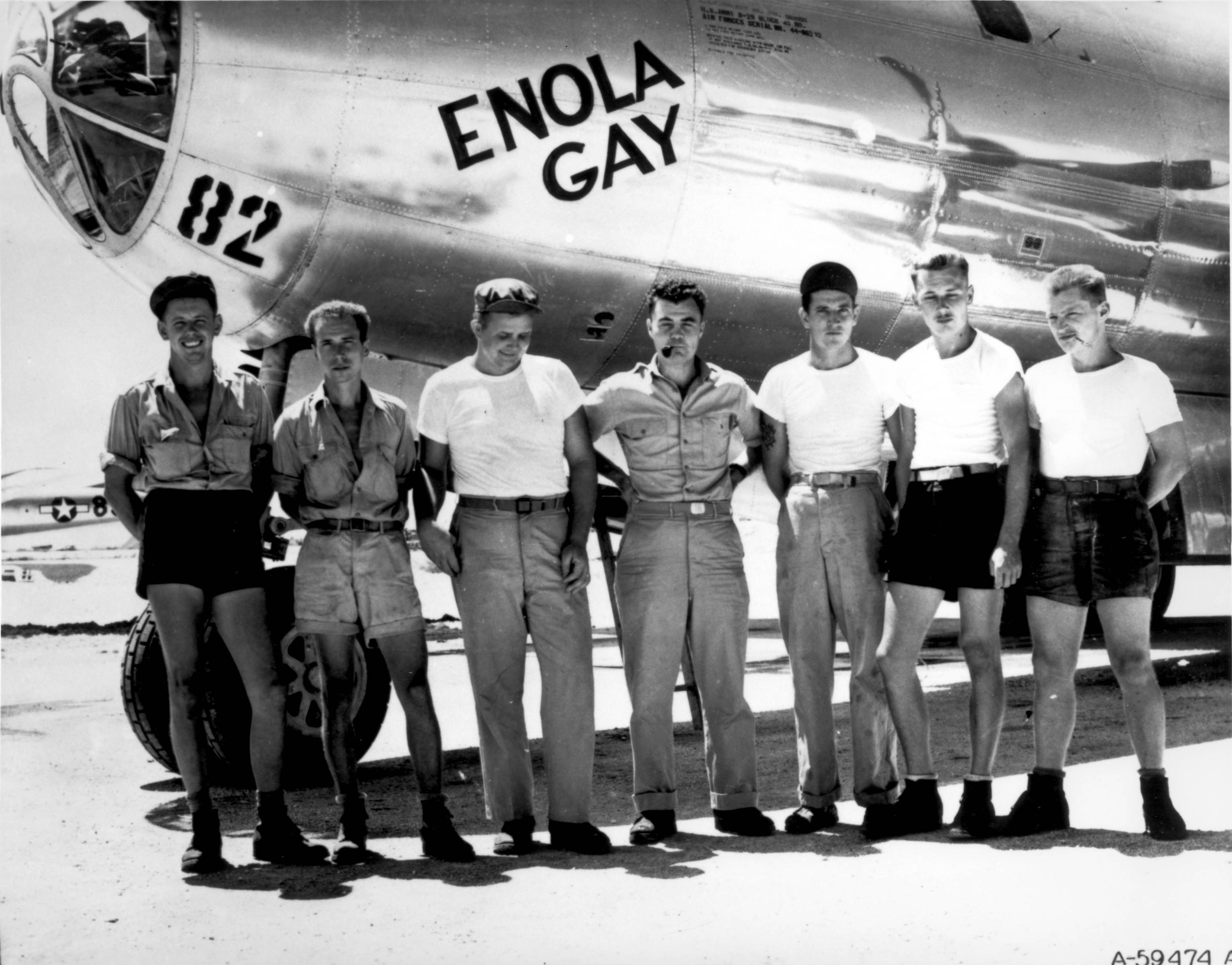
Before the bombing of Hiroshima, the population of the city was estimated to be around 255,000. This city was relatively flat and was densely populated. Many buildings were constructed with reinforced concrete in order to withstand earthquake damage. Hiroshima housed a military base that served as a communications center, storage point, and assembly area for the Japanese army.
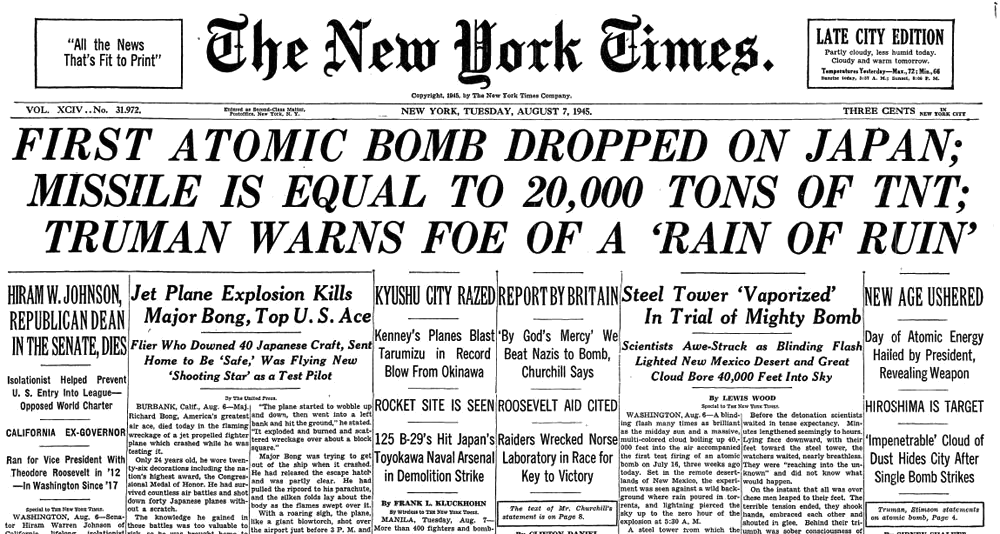
At around 8:00 a.m. that morning, a Japanese radar operator detected three planes flying near Hiroshima. These planes were American weather planes noting visibility for the bombing that would occur. Due to the small number of planes, Hiroshima citizens were encouraged but not required to seek shelter. At 8:15 a.m., Little Boy detonated producing a blinding flash and a booming sound.
Due to crosswinds, the Enola Gay missed the original target of the Aioi Bridge and directly hit the Shima Surgical Clinic. Total destruction occurred within one mile of the epicenter (ground beneath = hypocenter). All buildings, with the exception of reinforced concrete, were completely leveled. Extending to 5700 feet from the epicenter, most steel-framed buildings showed extensive damage. At approximately 6600 feet from the epicenter, multi-storied brick buildings had some degree of wreckage. In the city, over 69 % of the buildings were destroyed from the blast. Overhead electrical installations (power lines) were destroyed at a distance of over 5500 feet from the epicenter.
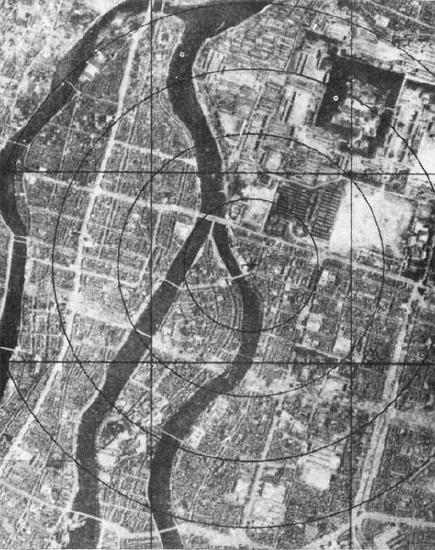
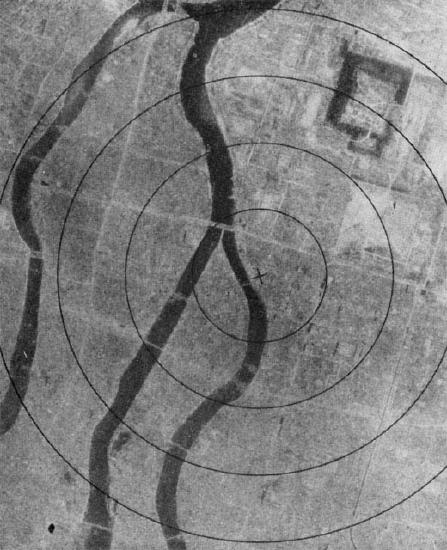
Within a few microseconds of detonation, gamma, ultraviolet, and visible radiation were emitted to the surrounding areas. Shortly thereafter, a large ball (several hundred feet in diameter) was produced. Intense temperatures( (in excess of a million degrees Celsius) and changes in pressures (19 tons per square meter) ultimately produced a growing shockwave. With the formation of a mushroom could, particle (mainly alpha and neutron) and wave (gamma, ultraviolet, and visible) are emitted a second time.
93% of residents who were up to 1000 feet of the epicenter died immediately. Deaths were attributed to thermal burns (from wave radiation), vaporization, flying debris, and extreme radiation exposure. Residents who were about 5,000 feet (almost a mile) from the epicenter had a 49% mortality rate. A distance of 10,000 feet (almost two miles) from the epicenter ensured safety. Individuals who were inside a structure were more likely to survive the detonation. Obviously, reinforced concrete structures provided more protection than wooden or bricked facilities. At Hiroshima, around 60% of the mortalities were attributed to severe burns. Falling debris killed around 30% of deaths. Lastly, pressure changes and radiation exposure killed the remaining 10%. In total, 60,000 - 70,000 people died immediately after the detonation of Little Boy. Within three months of this date, the total would increase to over 130,000 people.
Nagasaki (August 9, 1945)
Three days after the bombing of Hiroshima, the Bockscar with its crew flew towards Kokura. Piloted by Charles Sweeney, this plane carried the plutonium weapon, Fat Man. As with the Enola Gay, the Great Artiste accompanied the overloaded B-29. On that morning, the Bockscar passed over Kokura three times attempting to drop its nuclear bomb. Cloudy weather prevented the crew from arming the weapon and the target was abandoned. Determined to still use the plutonium weapon, the Bockscar flew towards Nagasaki. At 11:02 a.m., Fat Man detonated 1700 feet above the city. Releasing over 20 kilotons of energy, the bomb exploded between Mitsubishi Steel and Arms (weapons facility) and Mitsibushi-Urakami Works (Torpedo factory). The plane immediately rerouted to Iwo Jima due to a fuel shortage. Hours later, the Bockscar returned to Tinian Island. Like the Enola Gay, both sets of crews were not harmed on either mission.
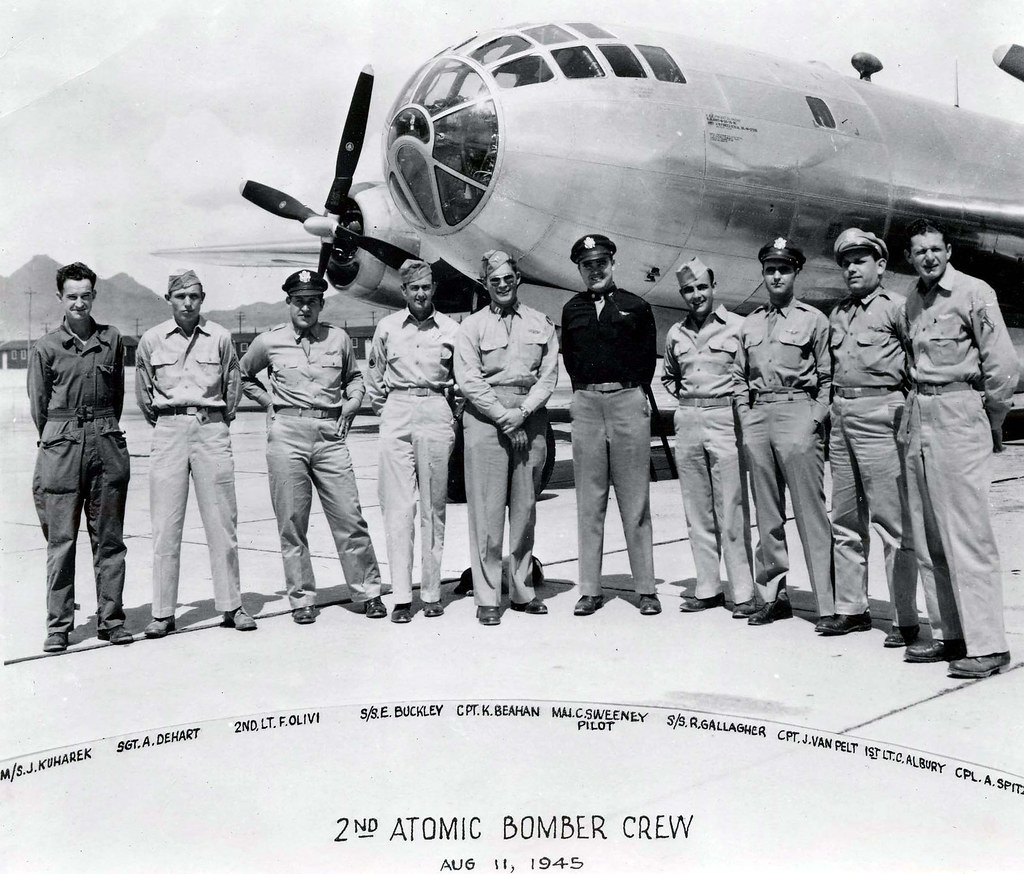

The pre-bomb population of Nagasaki was approximately 195,000 people. Nestled between mountains, this city was contained in a valley. Differences in topography and population densities resulted in fewer casualties than the Hiroshima bomb. The larger plutonium weapon instantly killed between 35,000 to 39,000 residents. Within a year's time, a total of 65,000 people would perish.
Being a larger weapon, Fatman had a larger destruction radius when compared to Little Boy. Over 30% of Nagasaki was completely destroyed. Steel framed buildings were severely damaged within 6000 feet of the epicenter. Multi-stored buildings sustained significant destruction 6500 feet from the epicenter. At Nagasaki, damage of Japanese homes extended to over 10,500 feet from the epicenter (compared to the distance of 8000 feet at Hiroshima). Nagasaki had fewer buildings constructed with reinforced concrete. Wood-framed buildings provided little to no protection for this city's residents.
95% of the deaths at Nagasaki were due to burns (gamma and ultraviolet). The remaining percent could be attributed to falling debris, glass, and radiation illnesses. Within 4900 feet of the epicenter, approximately 67% of the residents died. The epicenter distance of 6500-9900 feet (1.2-1.9 miles) resulted in an approximately 14% casualty rate. Differences in population density and topography of area resulted in fewer deaths in Nagasaki than Hiroshima.
.jpg?revision=1)
On August 15, 1945, Emperor Hirohito publicly announced the surrender of Imperial Japan. Aboard the USS Missouri battleship, members of the Japanese government signed the Japanese Instrument of Surrender on September 2, 1945.
Watch from the 32 minute mark to the end of the History Channel's Manhattan Project and answer the questions below.
- How powerful was the plutonium test bomb (in tons)? Which bomb would be dropped first?
- What was the purpose of the petition at Oak Ridge? Did the other labs (Los Alamos, Hanford, and Chicago) get to see the petition?
- Give some reasons as to why America still chose to drop the bombs.
- Why were certain cities in Japan not bombed during 1945?
- When and where was Little Boy dropped? Give the time of day as well. How powerful (TNT) was it.
- How did Paul Tibbets' describe Hiroshima?
- What was the death toll at Hiroshima?
- Where was Fatman dropped?
- When did Japan surrender?
- When did Russia detonate their first nuclear weapon?
- What did Edward Teller design?
- What was Oppenheimer's attitude toward furthering nuclear bomb research?
Need more practice?
In section 6E, answer questions 6-8.


